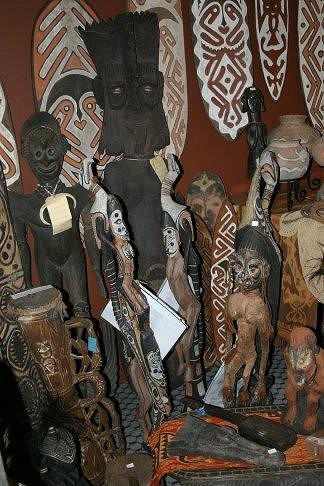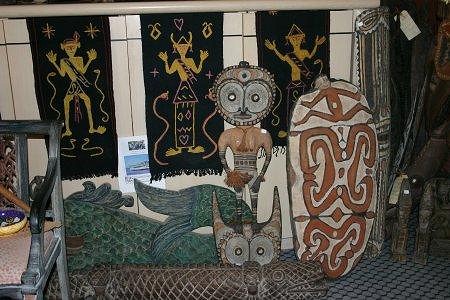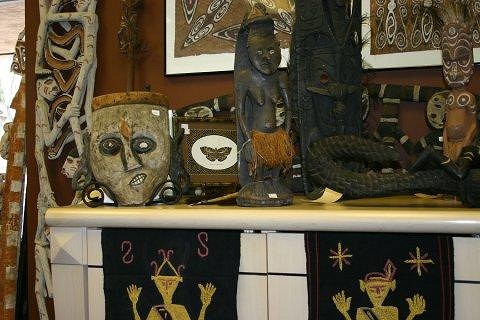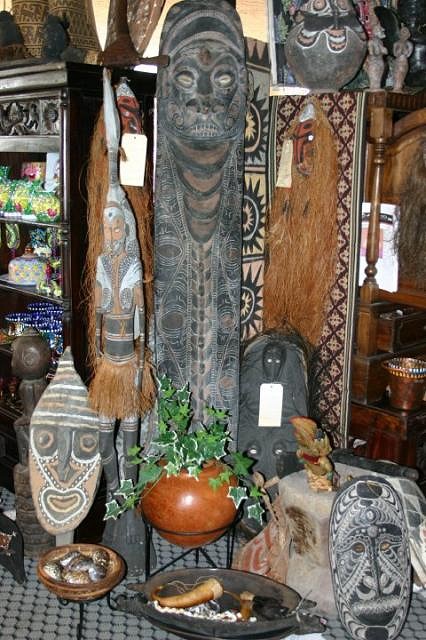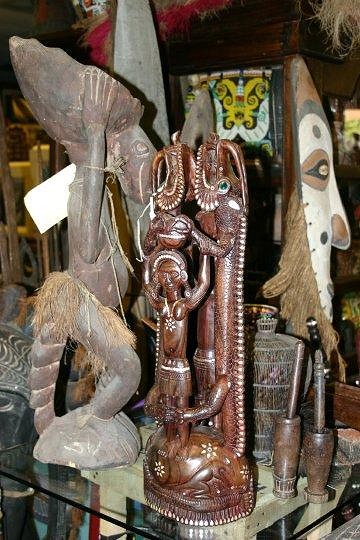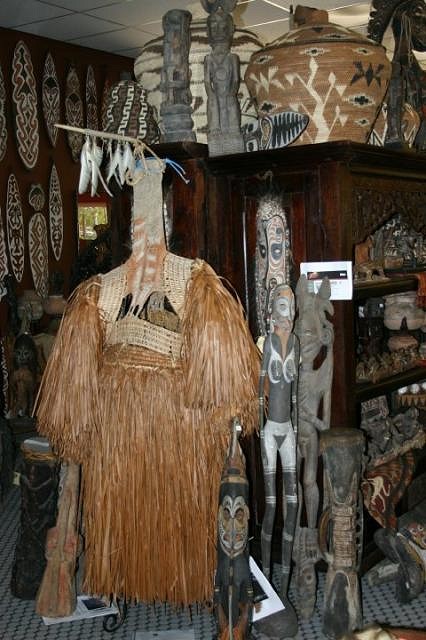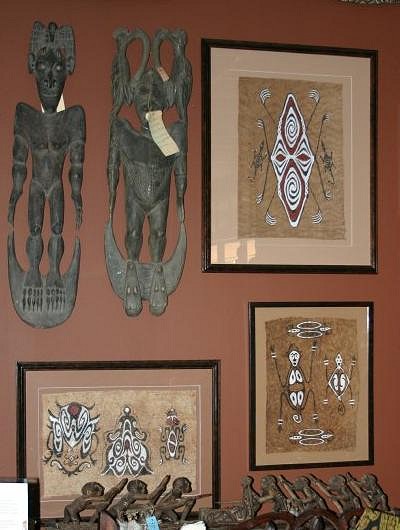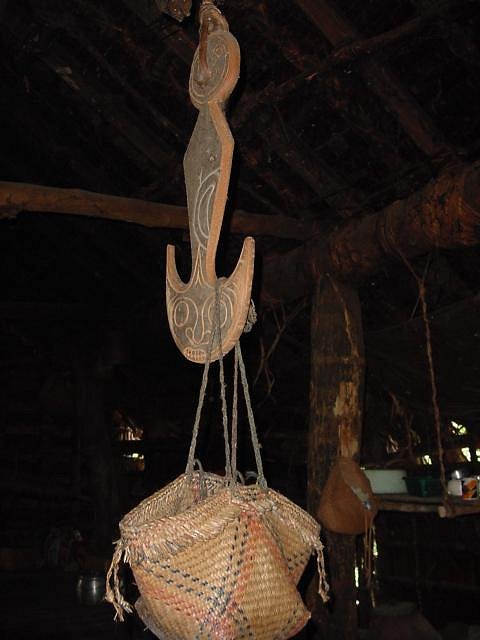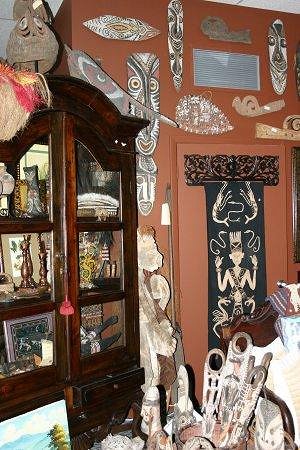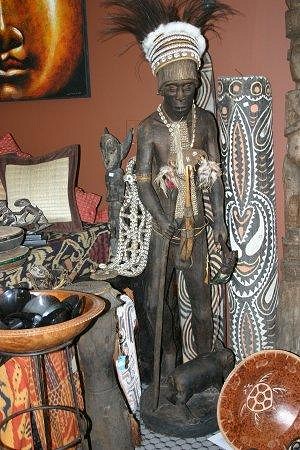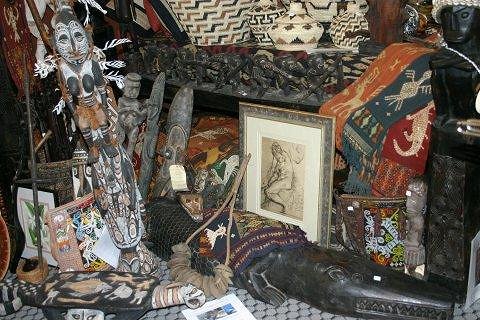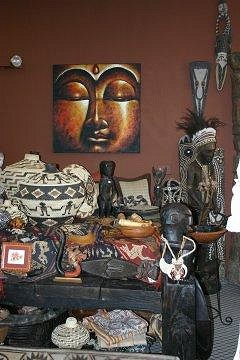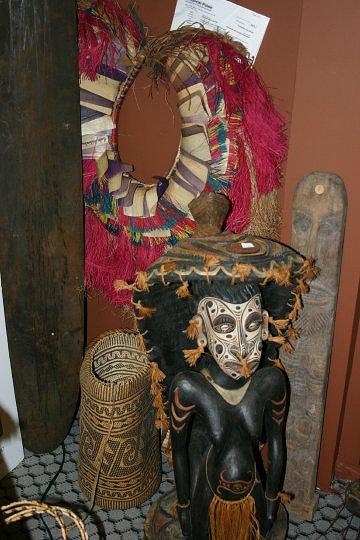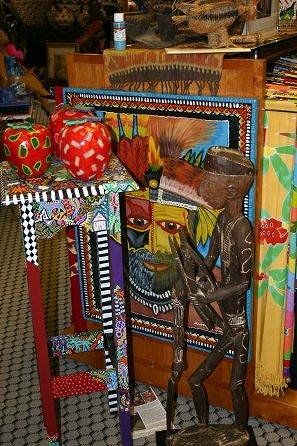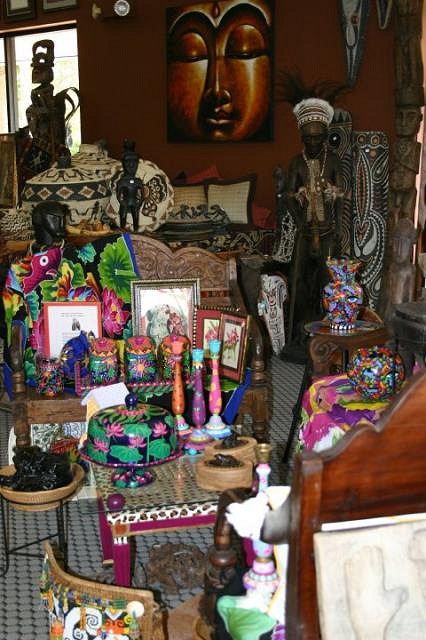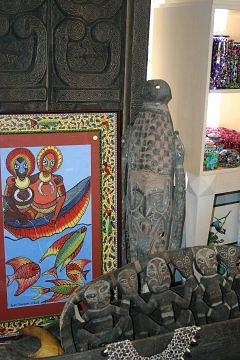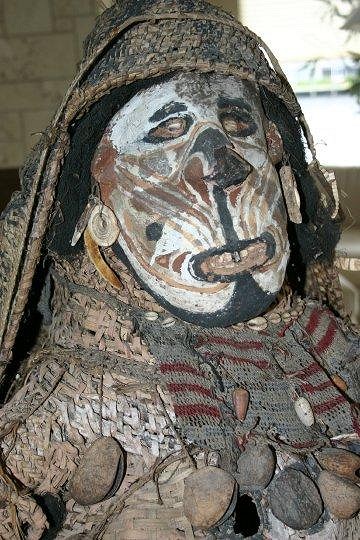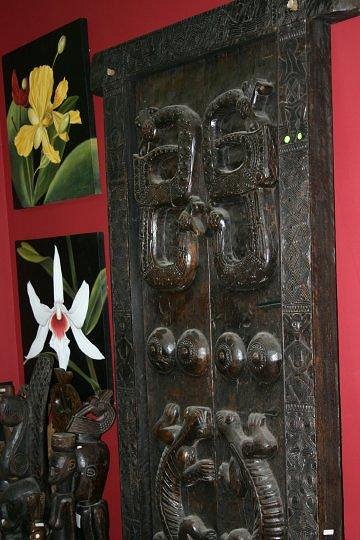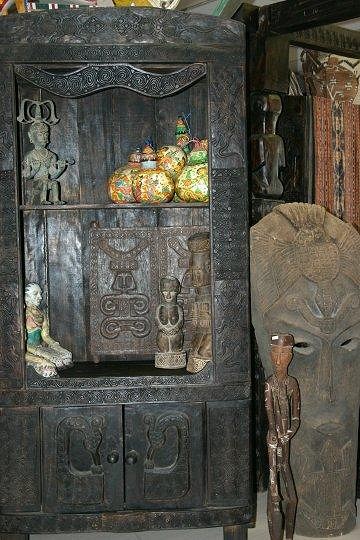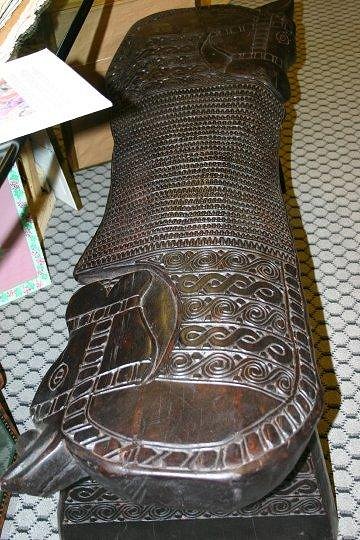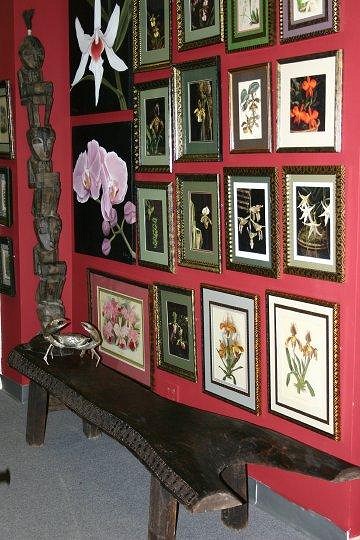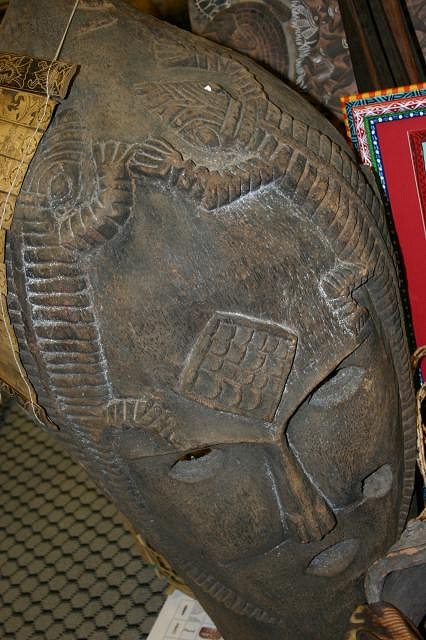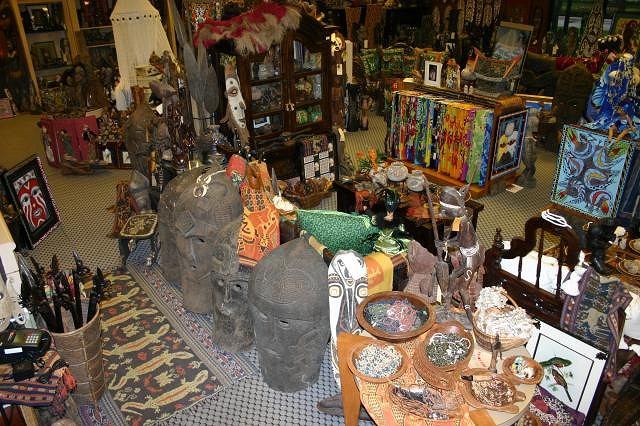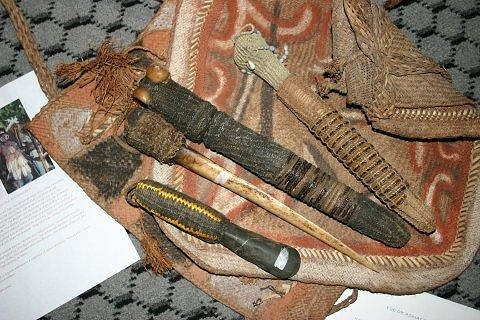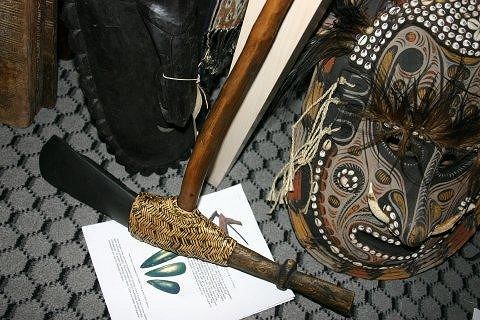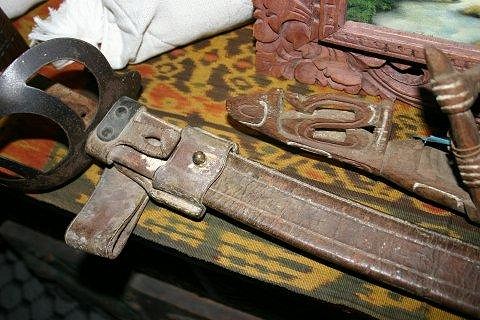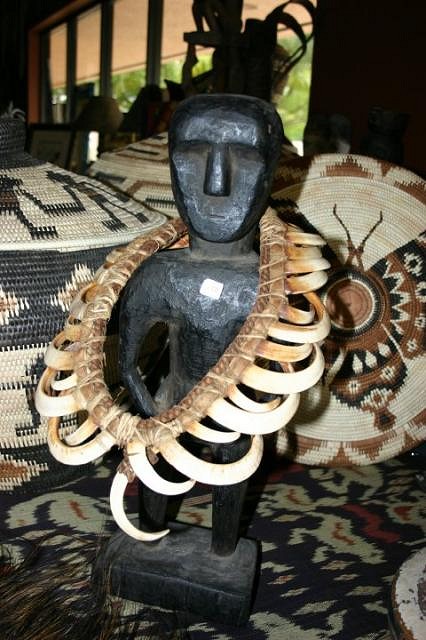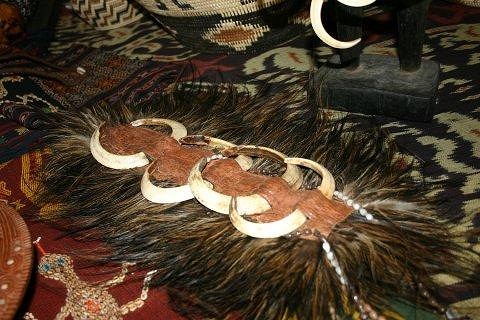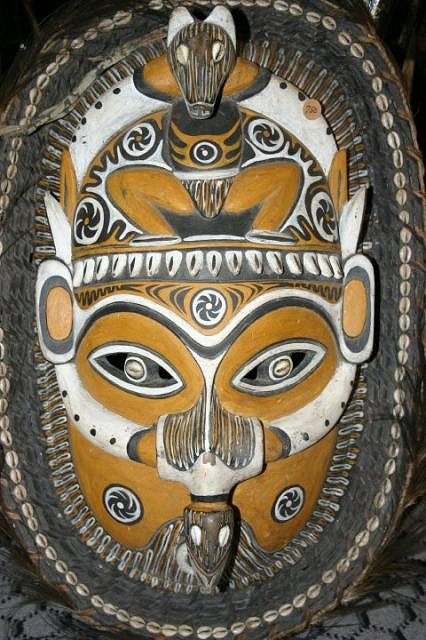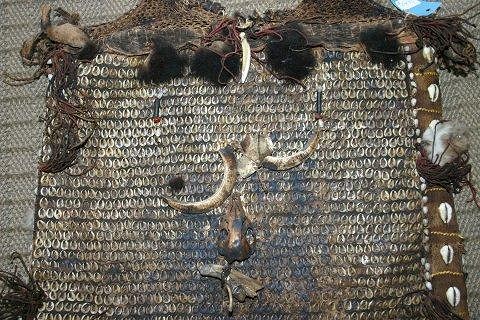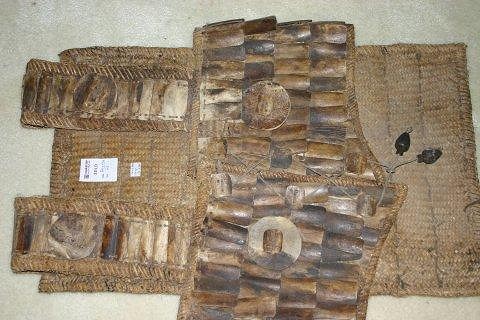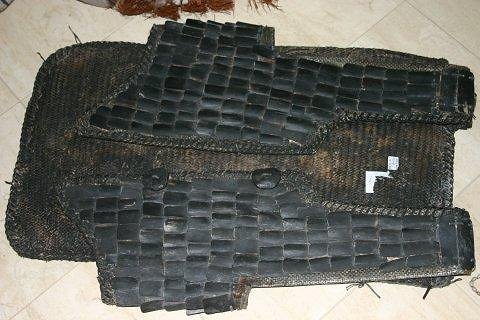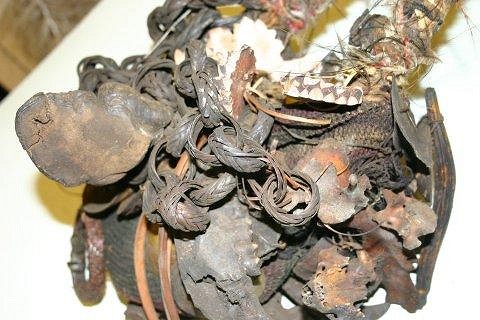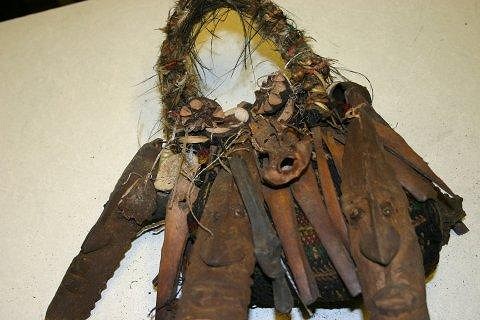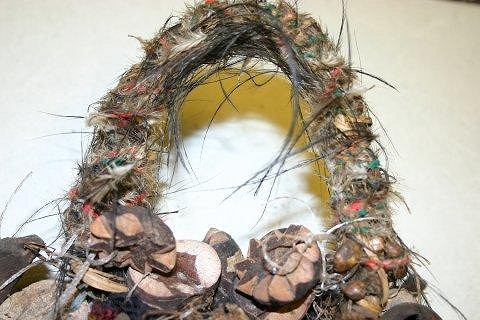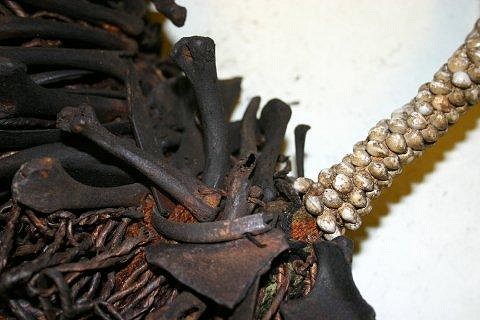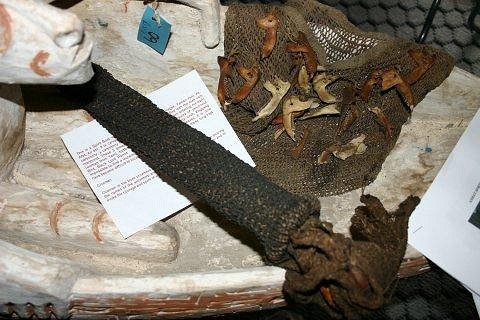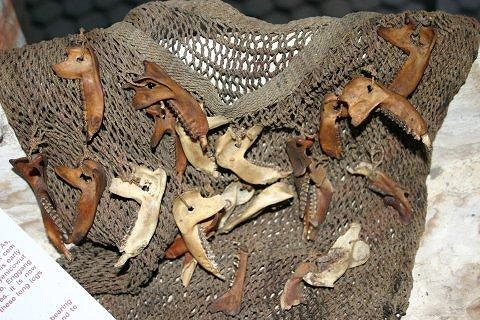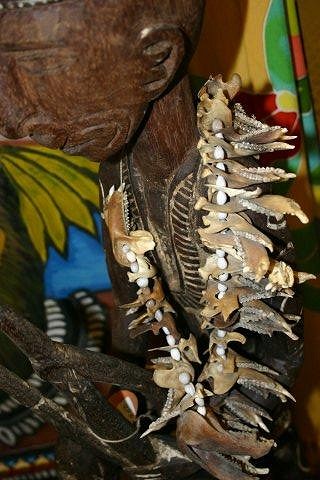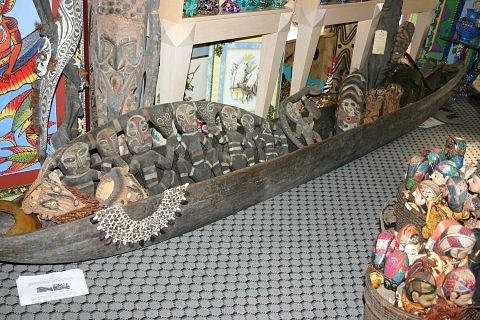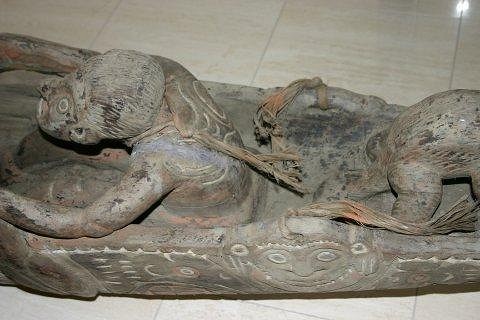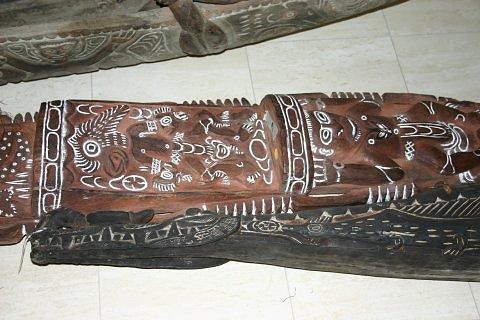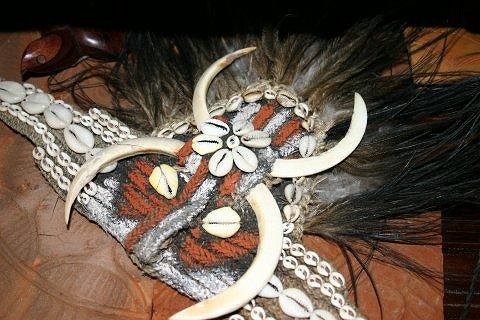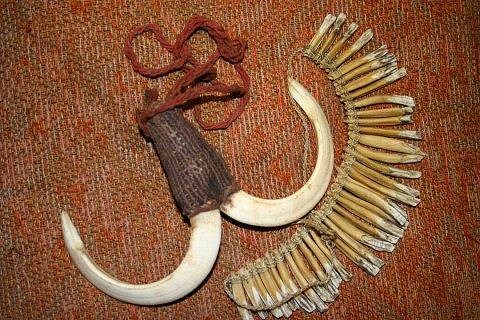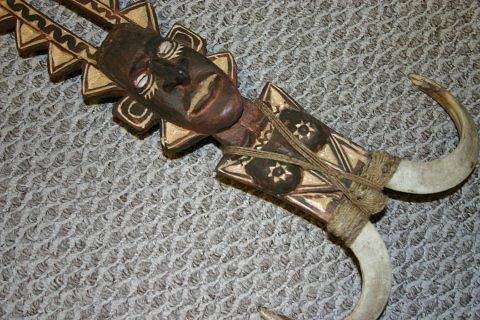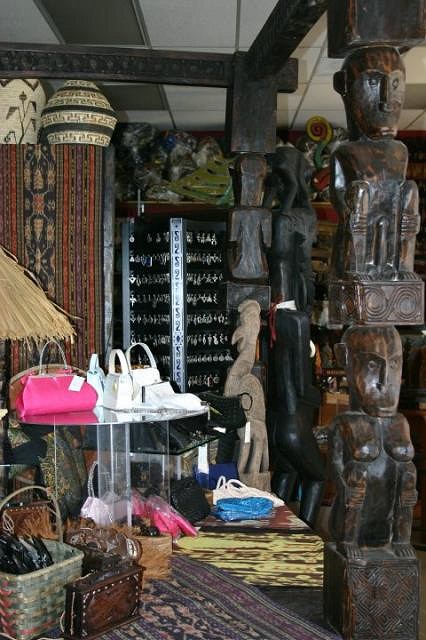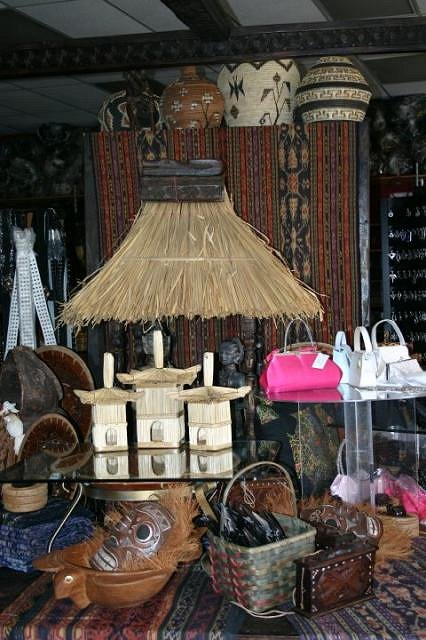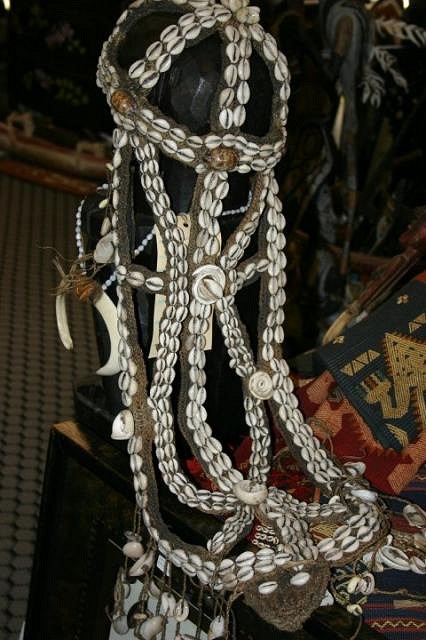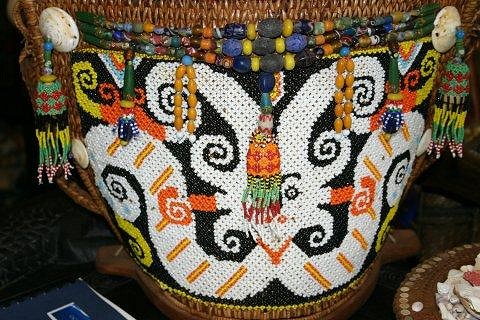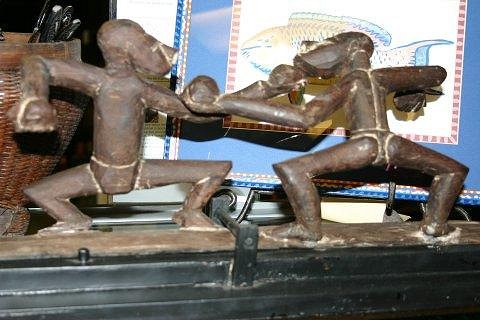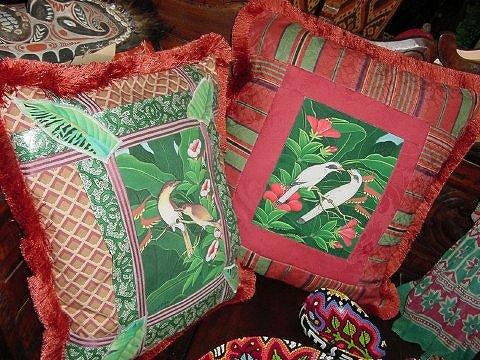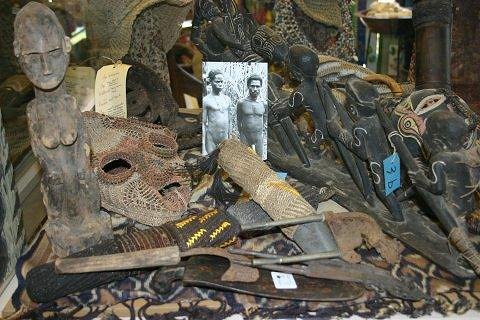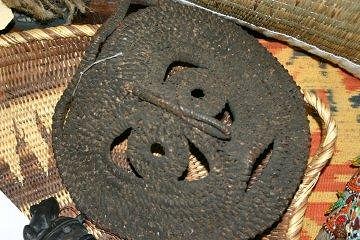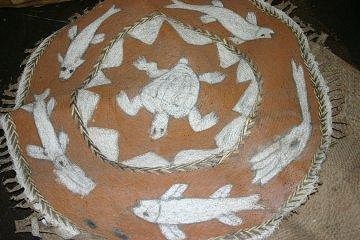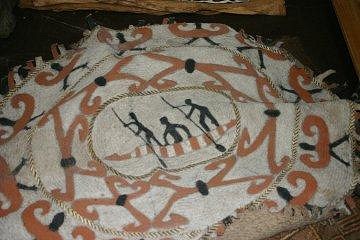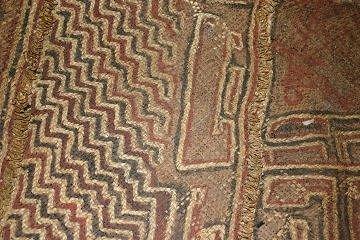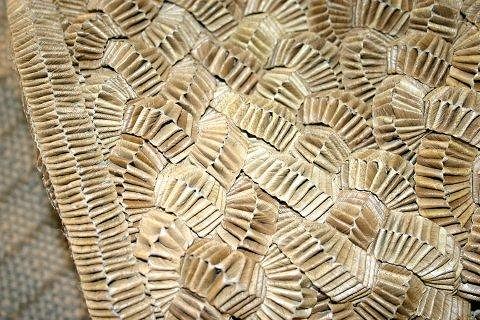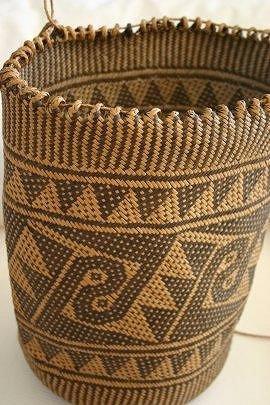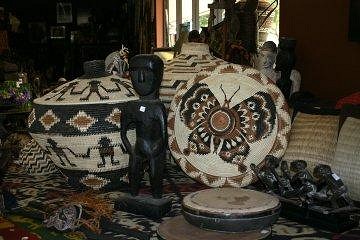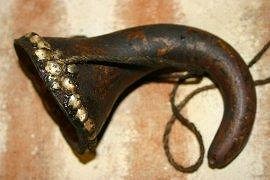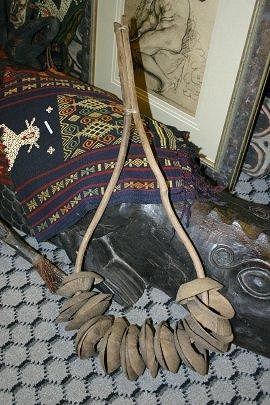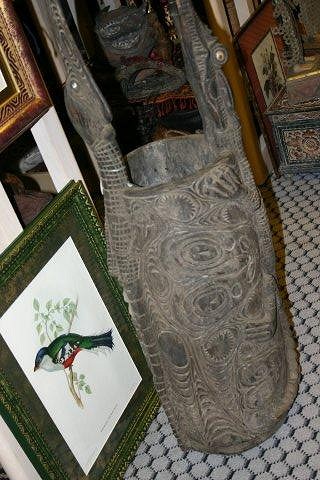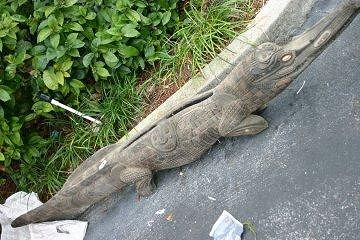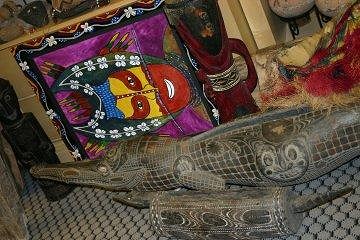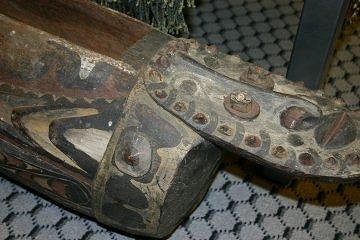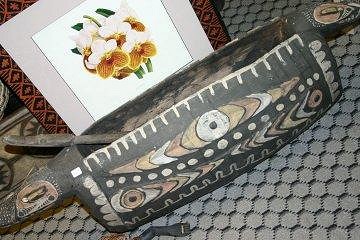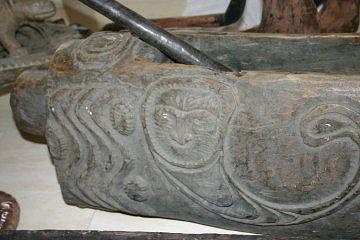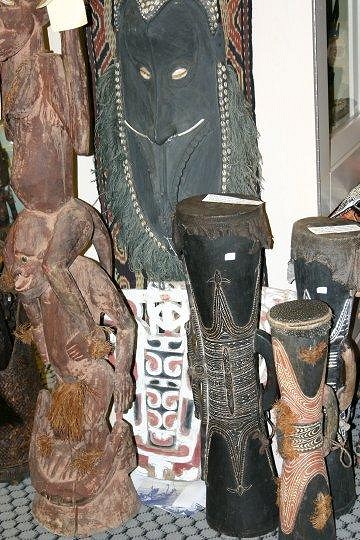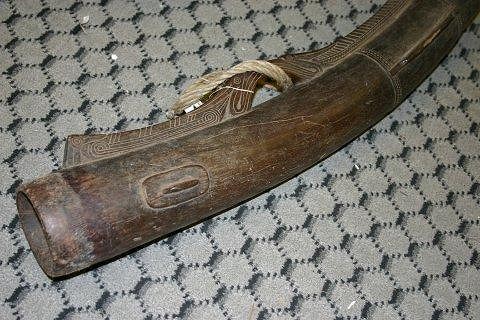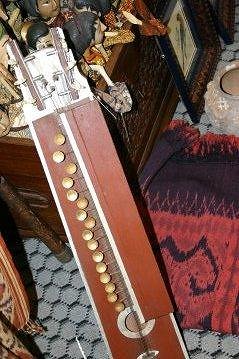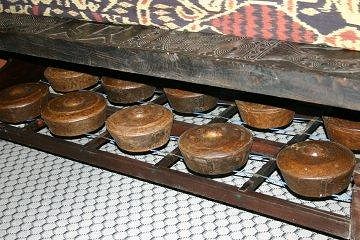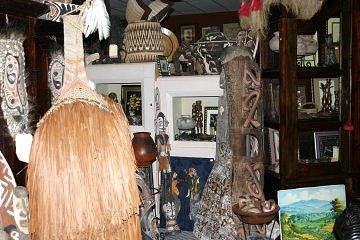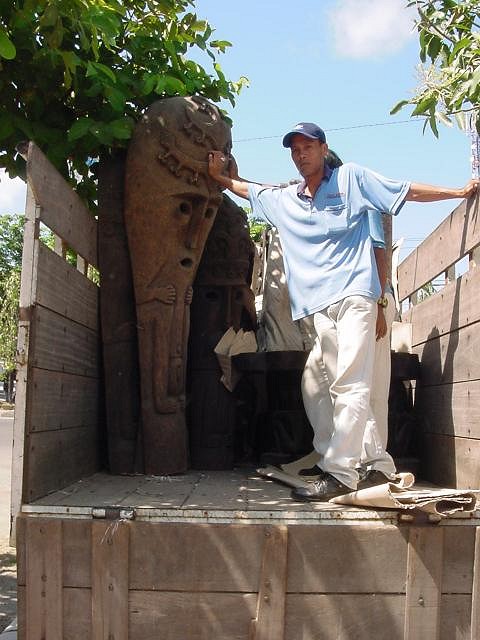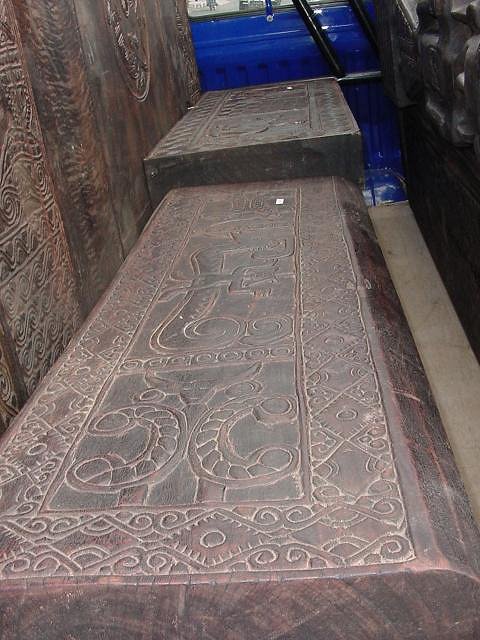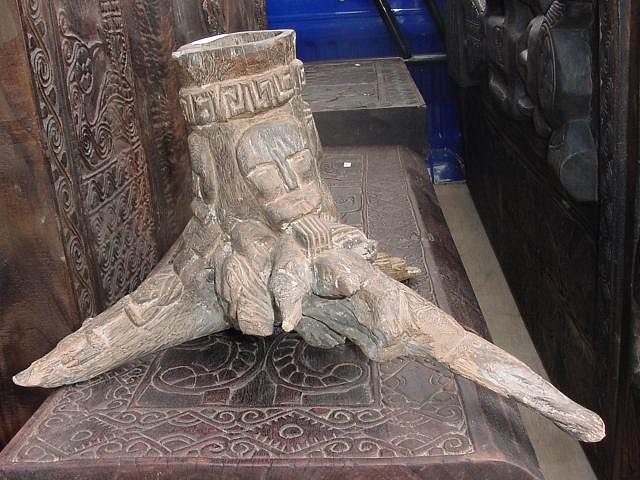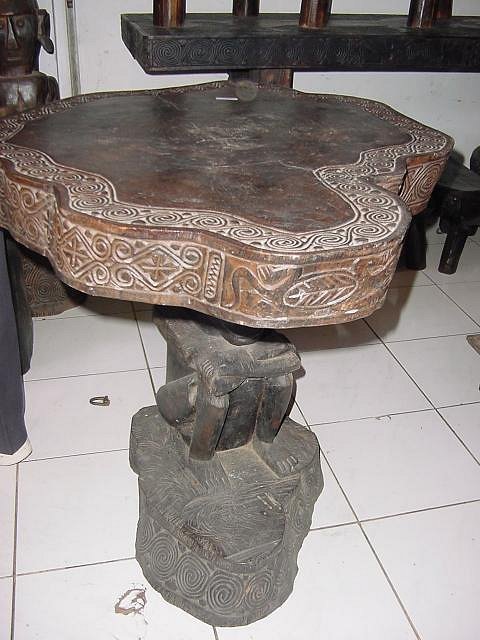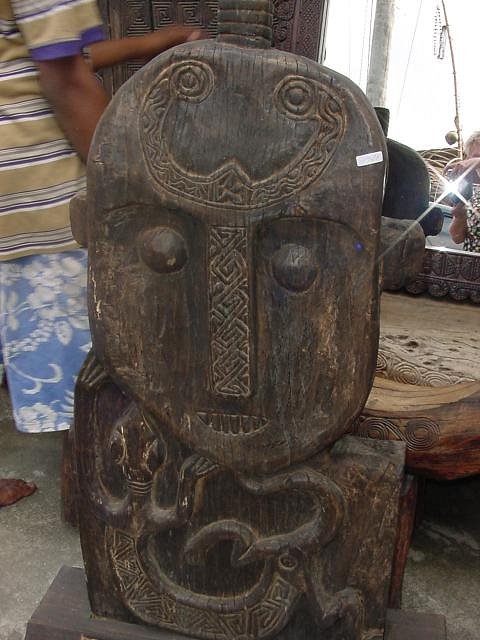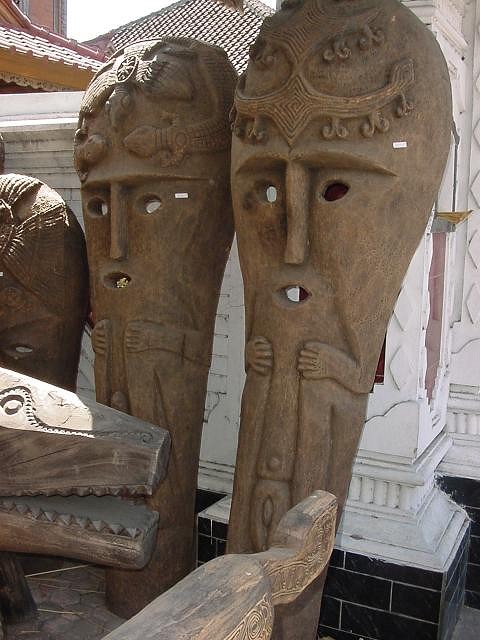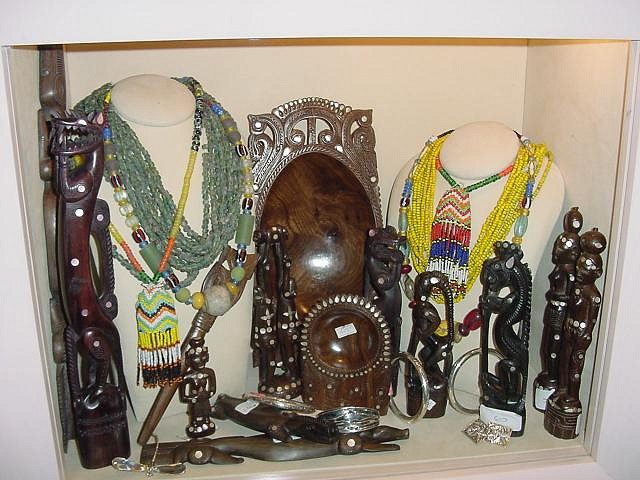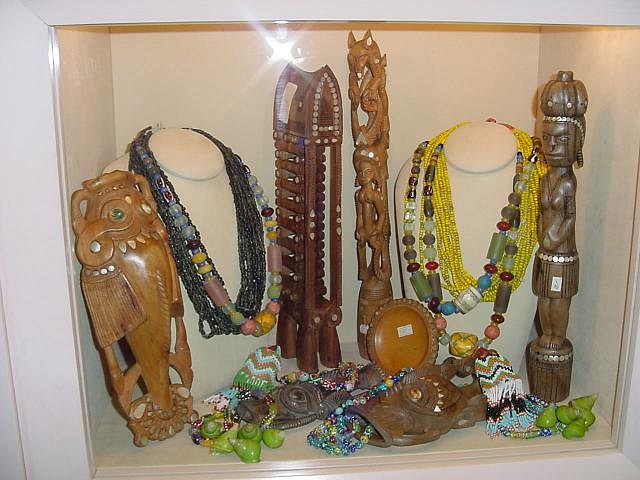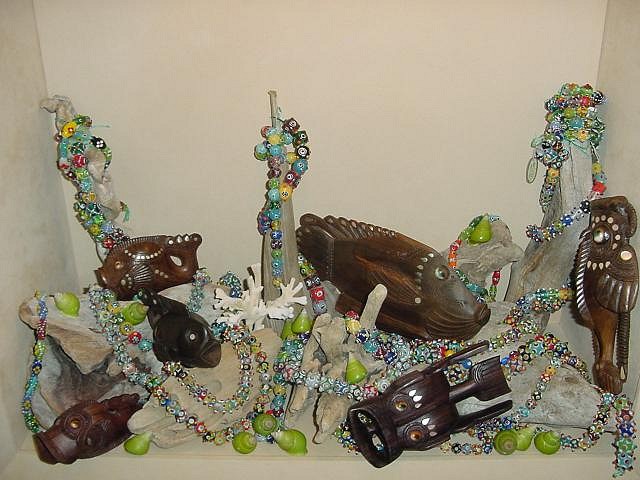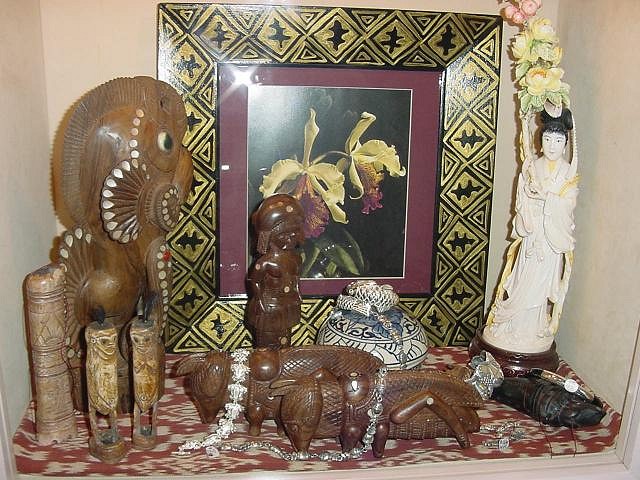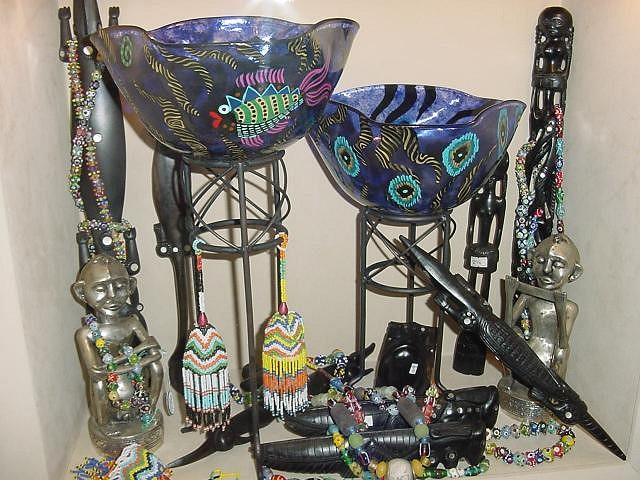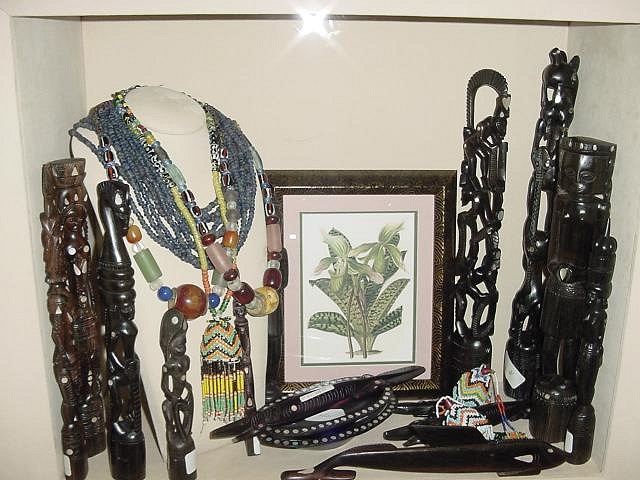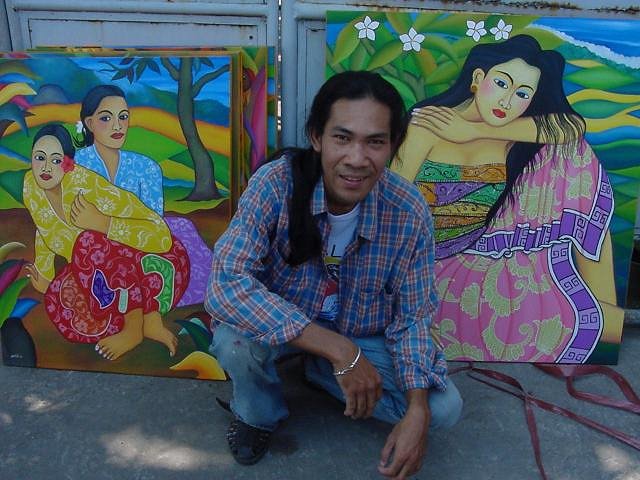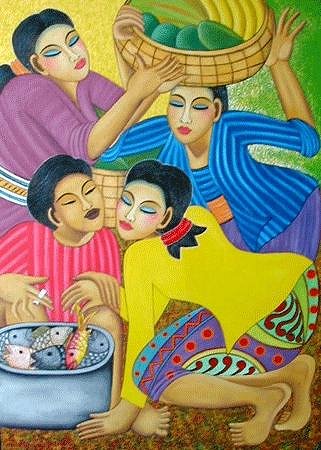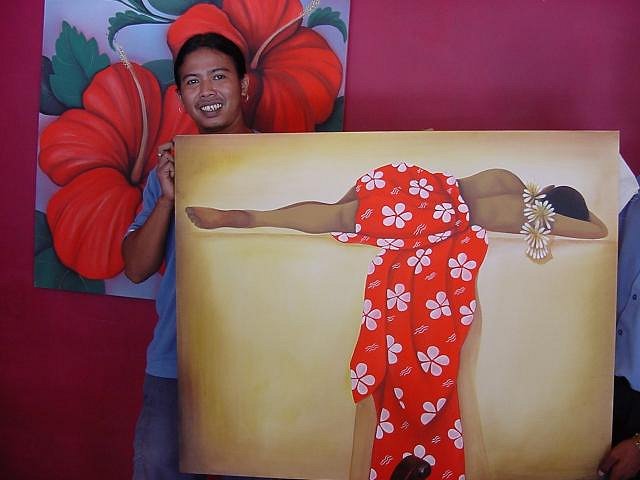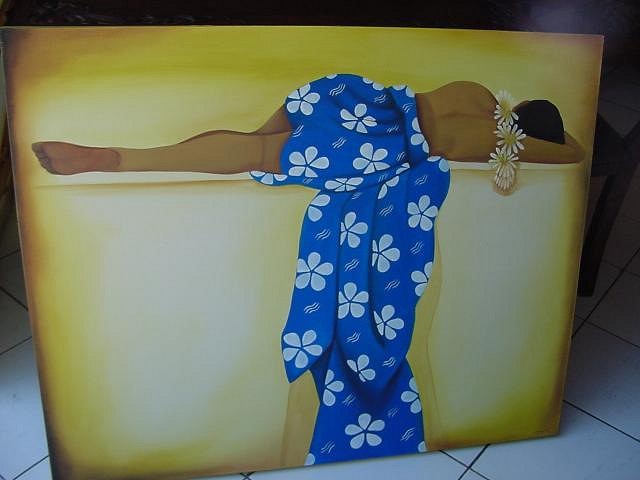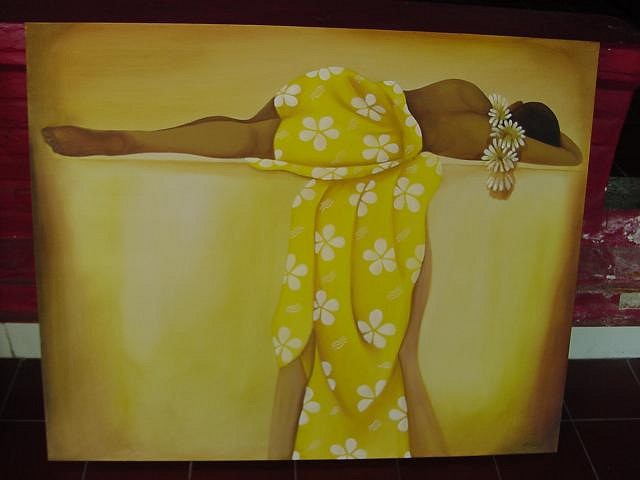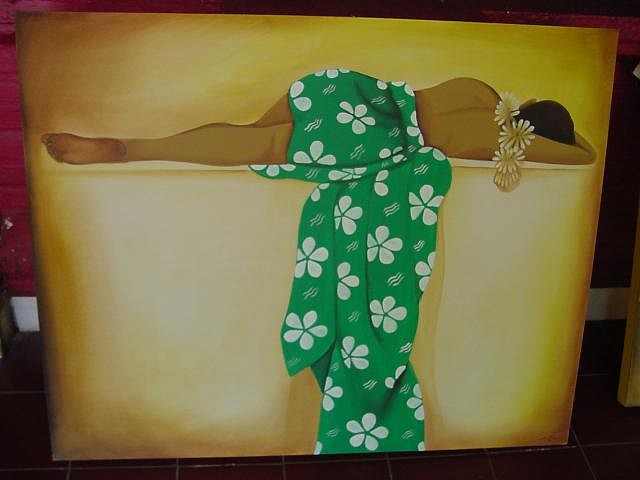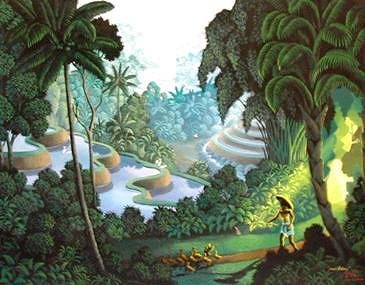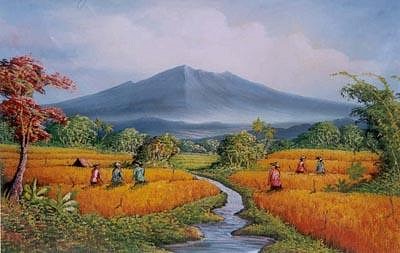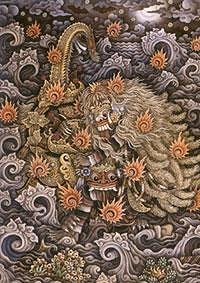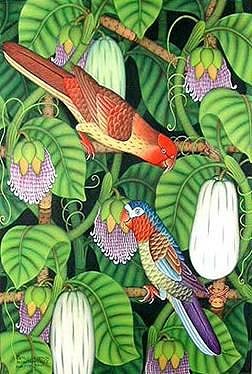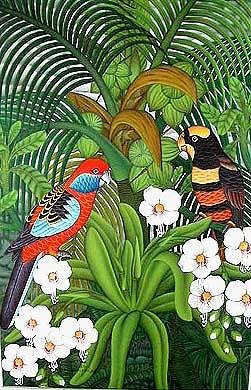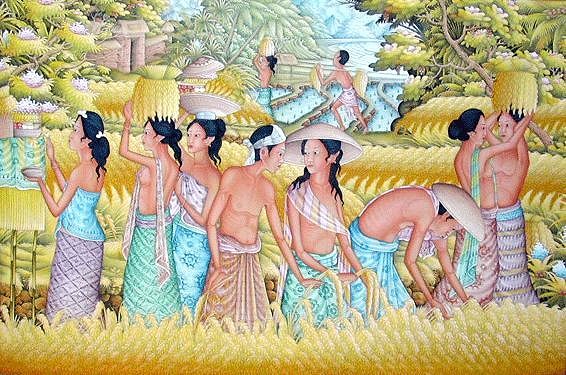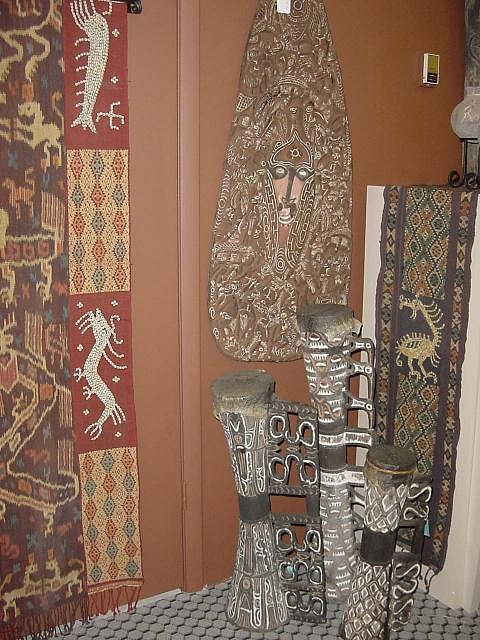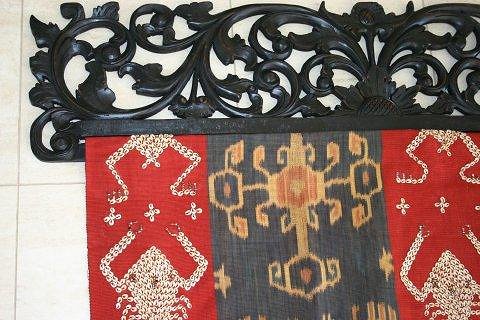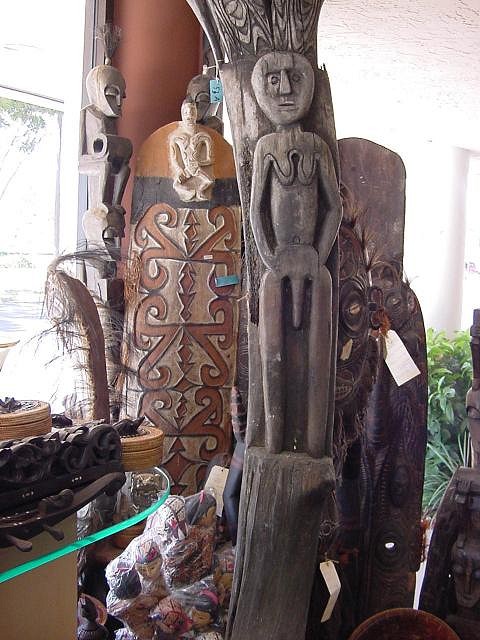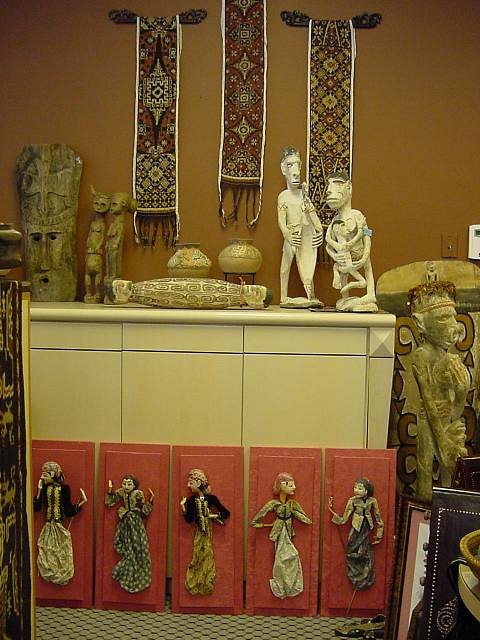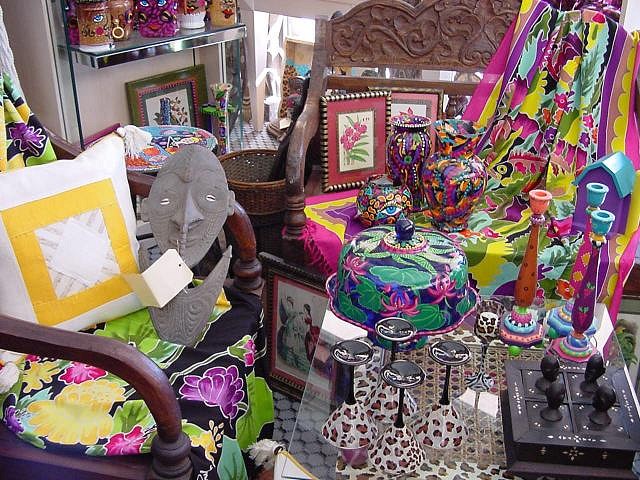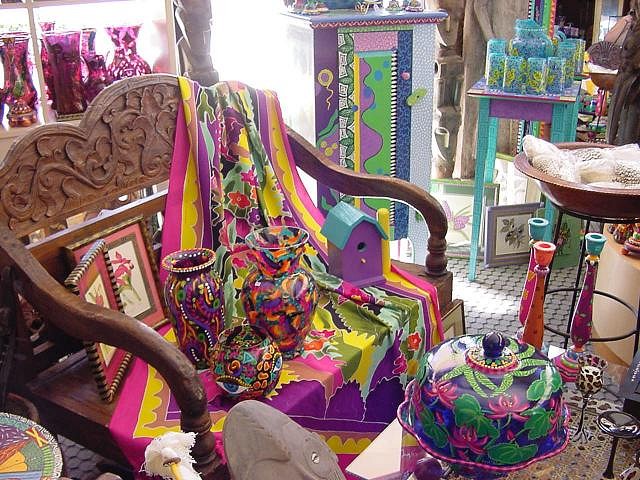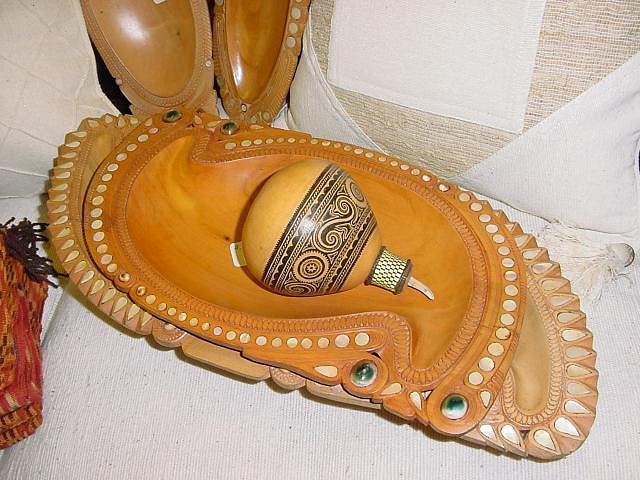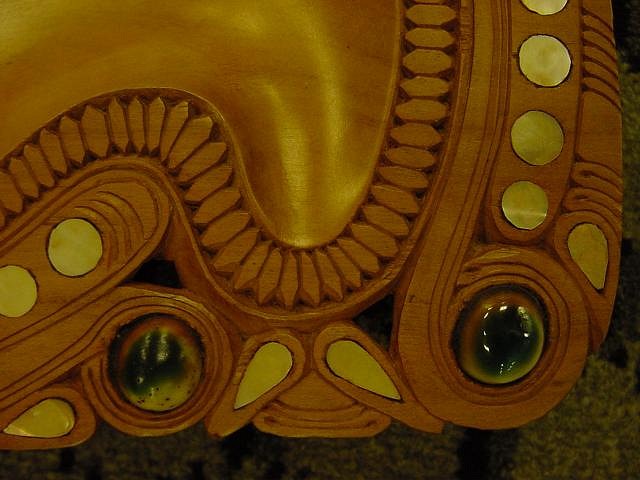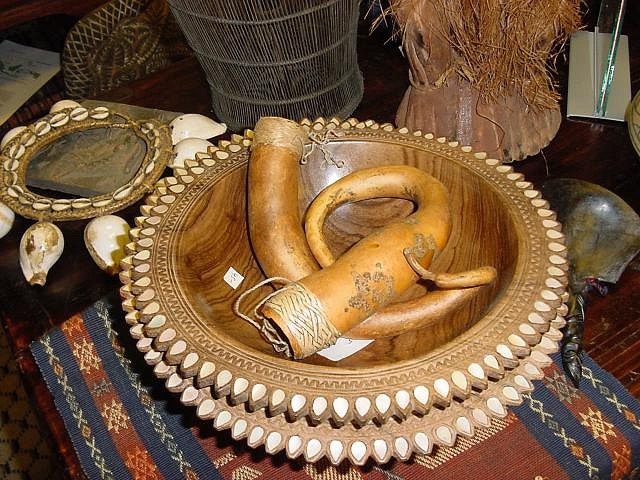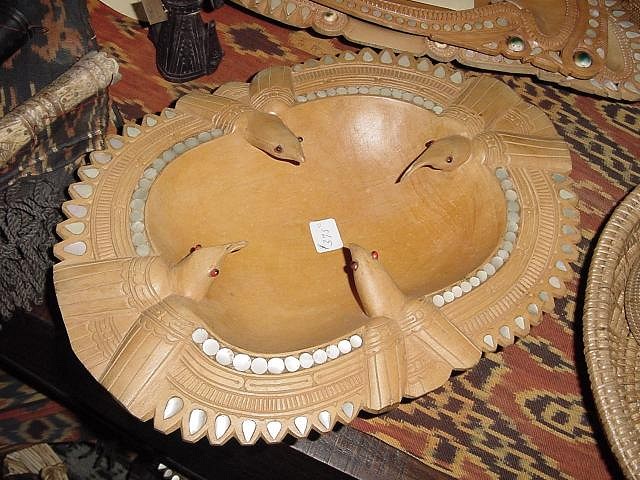Tiki Central / Collecting Tiki
Oceania, Etc: vendor of South Seas Art
|
IDOT

I dream of tiki
Posted
posted
on
Sat, Apr 30, 2005 5:55 PM
Fellow collecting ohana, I have very exciting news. I have just met a husband and wife pair with a large store full of artistic wonders imported from the Pacific. NOTE: On their request, I have corrected and added additional information to this post. The location: The store is located in a wee strip mall on the southeast corner of Lindell and Federal Highway. Dominique and her husband Gary travel to the Pacific every year and bring back carvings, rare statues and masks from Melanesia & other remote places, furniture such as unusual handcarved doors, armoires and beds, canoes, weapons, body wear, traditional costumes, jewelry, mats,etc. They primarily sell to collectors and decorators. They are very excited to show their finds to the TC ohana. Dominque is able to answer your questions about where the works are from and their cultural significance. Here is a list of the islands that comprise the works on sale: Papua New Guinea, Irian Jaya, Sumatra, Nias, Java, Madura, Bali, Borneo, Sumba, Timor, Sulawesi, Lombok, Sumbawa, Manus,and the Trobriands. Dominique also mentioned she had a few pieces from Australia. Gary and Dominique are willing to negotiate a reduction of up to 40% off retail price. Mr. Rice guaranteed that they'll give a 10% discount for purchases of $100 or more in either store. If you go, do call or email first to make an appointment. I'm willing to go with you since its in walking distance from my job. PM or email me. If you just go, please note the Rices are running their daughter's store,"Only Pocket change", which is next to Oceania,etc. Go into that store which is on your left, tell them that Liz Lang sent you, and ask to see their store. The daughter's store has some of their stuff too since they ran out of room in the main showroom. For me personally, I was a kid in a primitive candy store. They got such a kick out of my excitement to tell y'all. Added 11/24/05 Links to other Oceania, Etc. threads Photos of Melanesia Dominique's own art Oceania, Etc. Ebay store (Asmatcollection) [ Edited by: I dream of tiki 2005-11-23 05:34 ] |
|
B
Benzart
Posted
posted
on
Sat, Apr 30, 2005 6:19 PM
Dreamer, thanks SO Much for posting this. They are only 90 minutes from me. I HAVE to get there soon... |
|
M
McDougall
Posted
posted
on
Sat, Apr 30, 2005 11:04 PM
Only 30 minutes from me, thanks for the info, I'll check it out for sure, maybe meet Benzart there. (Hi Ben) |
|
B
Benzart
Posted
posted
on
Sun, May 1, 2005 7:45 AM
Hi Higi, Maybe we can do it. I'll have to talk to my chauffer. |
|
IDOT

I dream of tiki
Posted
posted
on
Sun, May 1, 2005 10:34 PM
BTW, I can arrange discount theatre tickets for any TC ohana who want to make a partial day of it in the area. The theater I work at is just south of Oceania over the canal. If you PM or email me with at least a days notice, I can make it happen. |
|
NR
Nokala Rocky
Posted
posted
on
Sat, May 7, 2005 6:01 PM
Went there on my short stay down south. Was closed! Had a number to call to get the artist to stop by and open up, but no answer. Oh well, next time! |
|
IDOT

I dream of tiki
Posted
posted
on
Sat, May 7, 2005 6:33 PM
Nokala Rocky, I'm so sorry that happened to you. I'm going to get in touch with Dominique to get a better idea on when they are running their daughter's store. If their daughter's store is open, then someone is there to open Oceania, etc. I'll post what I find. In the mean time, anyone wanting to see the store should please call or email them in advace to arrange an appointment. I especially apologize for not being clear. They may have an OPEN sign up but the doors are locked because they are running their daughter's store next door. Will post more info shortly. [ Edited by: I dream of tiki on 2005-05-08 13:50 ] |
|
IDOT

I dream of tiki
Posted
posted
on
Sun, May 8, 2005 1:46 PM
Nokala Rocky, I bring a message from Dominique. "Hi. You came to our store and it was closed. We are so sorry. I am the owner. I was at Disney with my granddaughter. The store was supposed to be open. However, my daughter, who was working there, had an accident in which a hammer fell on her head from the top of a ladder. She had to be rushed to the hospital and was not allowed to go back to work the next day. As mentioned, I was in Orlando. As a result, there was no one left to work and both stores were closed. I am so sorry about that. If you wish, I am happy to send pics of the inside of the store so you may get an idea of what we have. Let me know. Take care. So sorry again." |
|
NR
Nokala Rocky
Posted
posted
on
Sun, May 8, 2005 3:53 PM
Thank you so much for the responce! I'll be better able to buy something next time I'm down as I finally start work tomorrow. Sorry to hear about your daughters accident. I actually had that happen to me! Running up and down ladders and forgetting the hammer on the top shelf! The store looks fantastic! I spent about 5 minutes peeking through windows, but only probably saw less than half of what was in there! I'll be back! |
|
J

joefla70
Posted
posted
on
Mon, May 9, 2005 11:58 AM
OMG. I pass by that place every day on my lunch break from work and I never realized what it was until now! A few days ago, it crossed my mind that from the name, it might be a purveyor of polynesian art, but I had not yet taken the next step to enquire. Thanks for finding this, Idreamoftiki. By the way, where do you work? I'm at the Sanctuary Centre at the corner of Yamato and Federal Highway. [ Edited by: joefla70 on 2005-05-09 11:59 ] |
|
IDOT

I dream of tiki
Posted
posted
on
Tue, May 10, 2005 1:24 PM
Joefla70, I work at the Caldwell Theatre in Levitz Plaza. Yet another place you've been passing during your lunch break. Amazing what was under our noses this entire time. PM or email me sometime. Maybe I'll join you on one of your lunch breaks sometime. |
|
IDOT

I dream of tiki
Posted
posted
on
Tue, May 10, 2005 6:14 PM
Dominique asked me to post some photos of what she has in Oceania,etc. Very exciting.
The village of Palembei is graced with two haus tambarans which are the men's houses. Unquestionably the cultural life that persists so strongly in this village has much to do with their presence as they preside over the village with the ghost of the previous spirit house close by. The crumbling house’s posts of the previous building remain until they become one with the earth again further reinforcing the continuing cycle.There, master carvers, whose work appear in Art Exhibitions around the world, created beautiful slim polychrome statues inspired by their spiritual beliefs and traditional tales. While firmly based in tradition, these contemporary works abound with both innovation and individual expression (not withstanding the relatively crude implements including stone adzes and drills and the shark skin rasps and polishes which are used to produce works of delicate grace.) On the back wall are a few gope boards: In the Papuan Gulf province, located on the southern coast of Papua New Guinea, two dimensional works predominate superseding three dimensional sculpture in importance. Painting and relief carving is comprised of mostly symmetrical, curvilinear and chevron forms; red, black, and white compose the color scheme. Papuan Gulf art also shares stylistic elements with the central Sepik area and the northeast, suggesting a possible cultural link between these areas. Gope boards are elliptical in shape and incised with brightly colored abstract patterns. Warriors were entitled to have a gope board for each act of bravery and a board from the vanquished enemy's canoe held particular significance, transferring some of its previous owner's strength to the victor. Almost every ceremonial house contains numbers of oblong oval boards, with one side decorated with painted reliefs. Each of these gope boards is closely linked to a person or a special event; they are displayed with skulls of victims of head hunting rituals, either to protect clansmen from vindictive spirits of the enemy trophy heads or to enslave the spirits of the victims to the spirits of the gope."
"2)A food hook from Palembei, PNG with a big round face: Food hooks are used functionally to preserve food and they hang from rafters in the hut: Food goods are hung from the hook in bilums (woven bags) or baskets to keep it safe from rats and mice, and children too!. Suspending food from the food hook discourages vermin, and the spirit thought to inhabit the hook is believed to retard spoilage. Skull hooks or racks have a similar use and display hanging skulls of ancestors or enemies." "3) Behind the hook is a large handcarved green fish that was once hanging from the front of a decorated boat in Madura, East of Java. and on the right of the hook is an asmat plate reminiscent in design and color of the gope boards from a quite opposite area of this large island."
On the wall in back are seen some examples of framed tapa cloth from Irian jaya used in a region that has no cotton as a form of cloth and wear, made out of pounded bark and not woven then handpainted with motifs and natural pigments. The center statue represents a bride wearing the woven-with-nassa-shells' bride's veil shown on another of these sets of photos below."
Next to the statue on the right are 2 very old little lime containers and spatulas from the islands as well: Betel chewing is a central part of life in East New Guinea. Children even start chewing when they are a few years of age. Betel chewing is a mild stimulant which combined with lime reduces hunger pangs and produces a feeling of good humor, well being, and an increased capacity for work. The utensils used in chewing consist of lime containers, mortar and pestles to crush the betel nuts and lime spatulas like these that convey the lime to the mouth. All these items are decorated, the finest however being the work done on spatulas. Some carry highly stylized representations of human figures plants, or animals and should really be considered as miniature sculptures and intricate precise works of art. Betel chewing is part of working in the gardens, attending feasts, meeting friends, trade rituals, and making love for the people of East New Guinea and the Trobriands. Chewing the Betel Nut : The husk of the nut is torn away using your teeth, the kernel is then taken and placed in the mouth and chewed. From the chewing saliva will build in your mouth. It is important not to swallow ... you must spit. If swallowed it can make you feel a little nauseated. Keep chewing! Take the mustard and moisten the end then dip it in the lime. Place it in towards the back of your mouth and bite the lime-coated section off and chew, don’t forget to spit. At this point your spit should turn red and you may feel a little light-headed. The effect is largely due to your chewing technique. You make the day of any local if you accept a Betel nut. A friend of mine did, he could not stop spitting saliva for 3 hours and was foaming at the mouth! That was the only result we could witness! We had a good laugh! The other "must" is to indulge in some fat and juicy grub worms for a memorable lunch, good local proteins that you can undoubtedly find at the closest Sepik Mc Donald from you !!" :wink: [ Edited by: I dream of tiki 2009-02-20 22:59 ] |
|
IDOT

I dream of tiki
Posted
posted
on
Tue, May 10, 2005 6:29 PM
More pics
Asmat body masks are full-length costumes made of plaited cordage composed of rattan, bark, and sago leaf fiber. The body masks are usually painted with red and white pigment, decorated with carved facial features, and given skirts made of sago leaves. The end result depicts an otherworldly being, which appears only for special funerary ceremonies, known as jipae. For a mask ceremony, the village creates body masks. Once the masks were made, dancers donned the masks and became "spirits" of ancestors, dancing into the evening and night. In the morning, the spirits led a single-file procession through the village, viewing all the changes that had happened since the last ceremony, years prior, and since their death. They also call it "Baju Setan" (Ghost Armor). During a "Jipae" ceremony, the close relative of the deceased may wear it to symbolize the spirit or ghost of the dead and parades through the village while the children and women throw rocks presenting the act of the chasing and sending the ghost to the spirit world."
Long ago there was a woman who lived on a load anchor in the middle of the Sepik River. She thought she was about to give birth to a child but instead she laid three eggs. Two eggs became eagles and the other a crocodile who dove into the water. The two eagles caught men and ate human flesh. The crocodile stayed under the water and watched this happen, then went up and killed the two eagles. The human ancestors saw this and then built the haus tambaran with the finial figures shaped as eagles with crocodile tails. The woman is always present as the mother of the eagle and the crocodile. In front, on floor, hand carved out-of-one-tree-trunk life-size crocodile from Timor, and above on the bed from Timor as well, a long hand carved sculpture of an asmat canoe full of warriors rowing towards the enemy and battle. In front on left is a headrest in the shape of a mythical animal with lots of colored carvings from the sepik region."
[ Edited by: I dream of tiki 2009-02-20 23:31 ] |
|
IDOT

I dream of tiki
Posted
posted
on
Tue, May 10, 2005 6:35 PM
More Colorful components of the collection
In very front, statue from palembei: bride wearing bridal cap again
"Few masks are worn directly over the face, which explains the lack of holes for eyes. Some are fastened onto a large cone-shaped wicker framework for a dance costume called a tumbuan. Raffia is knotted into the bottom hoop for skirting and flowers, fruit and leaves added on for color and power at the time of the ceremony. Other masks are made only for display, most often in the men's Haus, to attract powerful and useful spirits. The individual elements of the masks are complex, they often refer directly or indirectly to ancestor or clan spirits and totems such as pig, cassowary (muruk), crocodile (pukpuk), eagle (taragau), or a water and bush bird (saun). There are many different types of masks for different purposes. Short nosed wickerwork masks, such as this one, represent females but they are rarer. The male masks-costumes are worn with skirts to the knee, while the female skirts stop at the ankle. They represent the face of a supernatural being, a totemic clan ancestor, and are affixed, for the initiation dance of boys, to the woven body shroud called "tumbuan" (which in turn represents a spirit from the era of the creation). Any mask used in such ceremonies was closely associated with the supernatural because initiation involved, amongst other things, communion with the clan spirits. The masks represent the spirits of totemic names. Names are very sacred in PNG. No one actually says anyone's real name, including their own, for fear of drawing the attention of bad spirits or sorcerers. During initiations, the elder who wears the mask-costume becomes a spirit teacher who may say the important totemic names without evoking personal risk. He tells and calls out names for use in magic, for healing and for other spiritual uses. These names number in the thousands and only powerful men have this knowledge. Missionaries gave women catholic names but their real name remains a secret they will not divulge: they refuse to tell it to anyone in their own language as that would give other people power and control over them. If a village or clan has a lot of bad luck, the whole group may change their names and buy the rights to use masks from another clan in a different village in an attempt to fool the bad spirits or sorcerers. The resulting masks usually display characteristics of both groups. Each Sepik River village otherwise is independent and has a distinctive style of art. No two masks can ever be exactly the same, even in the same village. Each is crafted by a different artist, representing a different ancestor or spirit, reflects that artist individual flair and is therefore unique. As a matter of fact, copying is forbidden and sentenced by local law unless there is a formal agreement between the parties involved. Masks and Statues of Papua New Guinea’s cultures serve a variety of spiritual, cultural and decorative purposes. Most of the masks found in PNG are from the Sepik region, where the production and use of masks is an important part of traditional culture. Ancestral masks represent deceased clan ancestors, totemic creatures that assist the tribe by interceding on a high plane to provide food, prevent and cure illness, while spirit masks embody tribal spirits who inhabit the surrounding jungle, & may come to the help of the tribe to counterattack sorcery spells meant to arm them. Ancestral and spirit masks are not designed to be "worn" but are hung in men's houses, spirit houses and other locations of importance. Gable masks (usually woven from cane) are mounted on house gables to protect the occupants from the feared marauding spirits. It is interesting to note that if a mask or any other object, is carved with gnashing teeth or a protruding tongue it is not intended so much as an erotic object but meant to ward off evil spirits." [ Edited by: I dream of tiki 2009-02-20 23:17 ] |
|
H
hewey
Posted
posted
on
Tue, May 10, 2005 6:53 PM
Looks like they got some really nice stuff. Pitty it is on the other side of the world... Would love to see more pics of what else is there. |
|
JT
Jungle Trader
Posted
posted
on
Tue, May 10, 2005 8:42 PM
I want. |
|
J
Jawa
Posted
posted
on
Wed, May 11, 2005 6:19 AM
Hey Liz, definitely a great find! I will have to travel down there one of these days. It is especially cool to see stuff from the Dani and the Trobiands, as I had to write tons about them this semester. Very cool people...I would have liked being a Trobriand Islander before the missionaries and British got there, they are very "free spirited"! And then you have the Dani men with the penis gourds...gotta be careful around them, could poke out an eye. |
|
J

joefla70
Posted
posted
on
Wed, May 11, 2005 6:24 AM
Hewey... its ironic that its on "the other side of the world" to you... because some of the pictured items look as if they originated in your neck of the woods... in the Sepik river region of Papua New Guinea. |
|
NR
Nokala Rocky
Posted
posted
on
Wed, May 11, 2005 7:23 PM
Boooyyyy, can't wait to go back down! Gotta start the tradin biz back up again! |
|
IDOT

I dream of tiki
Posted
posted
on
Thu, May 12, 2005 2:09 PM
Hewey and others wanting to see more, ask and you shall receive. Just got these pics from Dominique today. Her own narrations on the pieces are included.
Enjoy [ Edited by: I dream of tiki 2009-02-21 22:22 ] |
|
IDOT

I dream of tiki
Posted
posted
on
Thu, May 12, 2005 4:15 PM
Post deleted due to discontinuation of regular store hours. [ Edited by: I dream of tiki 2006-03-29 13:29 ] |
|
IDOT

I dream of tiki
Posted
posted
on
Thu, May 12, 2005 7:48 PM
More pictures
[ Edited by: I dream of tiki 2009-02-21 00:37 ] |
|
T
Tikiwahine
Posted
posted
on
Thu, May 12, 2005 10:06 PM
WOW! Great pictures I dream of Tiki! I've got a hankering for a PNG mask, alas, I'll have to make a trip to that shop at some point I suppose. Mucho mahaloz! |
|
IDOT

I dream of tiki
Posted
posted
on
Fri, May 13, 2005 8:30 AM
First topic of the day: weapons and tools
Dani women are as tough as tough can be. When they chop their finger off with the stone, they first hit their elbow hard to divert the pain. Unbelievable the pain they can take! The next 3 weapons(2 shown with sheath, one without)are rare cassowary bone daggers from the femur of a large cassowary bird, hunted for food, for its feathers which are on many masks from the area and for its bones used as weapons when shaped in a point. The cassowary is a dangerous and evil tempered bird the size of an ostrich. It can disembowel a man in one kick of its powerful claws. All weapons are resting on a woven asmat bag from the region, with designs produced with natural pigments. Fascinating culture!"
[ Edited by: I dream of tiki 2009-02-20 23:55 ] |
|
IDOT

I dream of tiki
Posted
posted
on
Fri, May 13, 2005 9:50 AM
Next topic: Mask, Jewelry/adornments and armory
[ Edited by: I dream of tiki 2009-02-20 23:52 ] |
|
R
rodeotiki
Posted
posted
on
Fri, May 13, 2005 9:58 AM
What great photos. Thanks for sharing. |
|
IDOT

I dream of tiki
Posted
posted
on
Fri, May 13, 2005 5:27 PM
Sorcerers' Bags and other adornments!
[ Edited by: I dream of tiki 2009-02-21 22:33 ] |
|
IDOT

I dream of tiki
Posted
posted
on
Fri, May 13, 2005 5:45 PM
Canoes In the boat is a open carving that came from the top of a man's house from the Sepik region among other stuff i thru in there." [ Edited by: I dream of tiki 2009-02-21 00:04 ] |
|
IDOT

I dream of tiki
Posted
posted
on
Fri, May 13, 2005 6:25 PM
"Below is a set of stairs, 8 in total that were about 7 feet tall. The stairs has been sold as well but the story board carving all along is beautiful. Next to is is the prow of a full crocodile canoe." (See above post for more detail) This is worn by the chief on his head during singsings below, woven fiber, natural pigments, boar tusks, cassowary feathers, nassa and cowrie shells. Again great headgear for a night on the town. "Now a final treat for all tiki lovers, a rare poster bed from Timor. Completely handcarved throughout. Hard to see it as we use it for a display in my daughter's store that sells accessories but it is gorgeous. Came with a straw roof that we could not bring back. Used outside for timor naps or inside for florida naps! Only a portion is seen here. Hard to photograph the whole thing." [ Edited by: I dream of tiki 2009-02-21 22:45 ] |
|
IDOT

I dream of tiki
Posted
posted
on
Fri, May 13, 2005 6:56 PM
"Below is a rare Bride's headgear Ambusap head ornement from the Sepik known as a bridal cap. The same headdress can also be worn by men in the course of certain rituals. In that context, disguised as a bride, they represent an ancestress. It is the most significant piece of personal adornment worn by the Iatmul people, Lower Sepik River region, Papua New Guinea. Consisting of a woven natural bark fiber veil studded with both nassa and cowry shells, such headdress were once painstakingly decorated for countless hours, often with added attachments of pearl shell and bird's feathers. Often at the base of the veil is a skillfully shaped woven crocodile head. Such pieces, worn by a bride when she first entered the Men's House, are intricate and extremely rare." "Below is a mother's backpack baby carrier from the Kayan people of Central Borneo, used to carry her baby in the fields, the motifs are meant to repel evil spirits and protect the child as well as hanging talismanic decorations. The anthropomorphic figure in the center of the beaded panel suggests that this carrier was used by a family of prominent genealogy. Woven rattan backing, wood seat, plaited shoulder straps, various beads, shells, and bells for adornment and empowerment." "This is a fun Asmat piece that looks like 2 boxers! There are no boxers in Irian Jaya but these fighting tribal men imply such! I like that piece, it is unusual!" A different look, hand painted pillows, Balinese signed paintings are used within. Not as primitive as the rest! This glass case below has all sorts of artifacts from Irian jaya in it including a woven mask to be used in the next movie of Halloween the 13th! :lol: [ Edited by: I dream of tiki 2009-02-21 22:44 ] |
|
IDOT

I dream of tiki
Posted
posted
on
Sun, May 15, 2005 4:54 PM
Today's topic: Weavings
Closeups of Asmat matting
[ Edited by: I dream of tiki 2009-02-21 22:34 ] |
|
IDOT

I dream of tiki
Posted
posted
on
Sun, May 15, 2005 5:44 PM
Penis sheaths & phallocrypts.
[ Edited by: I dream of tiki 2009-02-21 23:31 ] |
|
IDOT

I dream of tiki
Posted
posted
on
Tue, May 17, 2005 5:55 PM
Musical Instruments
The community believes that the spirits of the ancestors reside in the shark body, especially the mako shark. And it was calling their ancestors that caused the shark to come. To awaken the spirits, the caller anoints himself and his canoe with secret herbs. Then he paddles out to the reef and symbolically spears the coral to arouse the spirit of Moro - the shark god. This done, he takes out a larung, a rattle fashioned out of bamboo and coconut shells, and begins shaking it in the sea which in fact create vibrations that attract sharks. Finally, he chants the age-old songs of the shark. If the shark answers the call, the hunter entices it to the side of his canoe and, softly stroking it, slips a loop of vine over its head. Then he clubs it to death.
"Water has had surprising prominence in the musical world. It has served as a tool, as inspiration, and even as a performing venue. Water Drums exist in various cultures. The native populations of the Americas constructed a drum within a drum, with the inner instrument being filled with various amounts of water to affect the timbre of the sound. In some areas in Africa and New Guinea, hollow gourds were placed in larger vessels and struck as well."
Slit gong drums known as garamuts are made of hollowed logs or tree trunks slit longitudinally along one side and beaten with sticks. Very large garamuts (up to 6 feet long) were used to summon people to war during head-hunting days, meetings, to pass messages to nearby villages, and to perform rituals. Medium-sized and smaller garamut drums are portable and can accompany performers to sing sings and cultural shows. The garamut as a means or form of non-verbal communication also made it possible for people to interpret certain messages being transmitted and also the interpretations of the sounds, codes and the different kinds of patterns of beats being performed or employed thus only well-skilled people handle the Garamut. Garamuts are kept in ceremonial houses and only men are allowed to play them. Garamuts are considered to have a spirit and they have names. They are powerful like masks and figures. They can kill people or make them sick. A garamut may take on other forms and walk at night. Garamuts are used in initiation ceremonies."
Mythology of the garamut: Sun carved slit-gong drums (garamut) from trees near the village, but none of them had a good sound. One night, Yirkaba changed herself into a tree and sent a leaf to tell Moon. Moon told Sun to hollow out a garamut from that tree. Sun cut a beautiful garamut from the tree. They named it Kabribuk, decorated it and brought it into the men's house in the village. It had a wonderful sound that carried very far. The splinters left from the drum became Yipwons. They lived as Sun's children, but stayed hidden in the men's house. One of Sun's relatives heard the drum, so he traveled to visit, but Sun was out hunting. The man went into the men's house to wait. The Yipwons tricked him and speared him as he looked into the garamut. He ran outside, but the Yipwons followed and killed him. They drank his blood and cut him to pieces. Moon was in a tree nearby picking leaves. She heard the noise and turned to see what was happening. The Yipwons realized they had been caught. They ran back into the men's house, stood against the wall and stretched up trying to look inconspicuous, stiff with fright. This is how they look today. When Sun returned and saw his dead relative, he was very angry. He decided to leave. The people returned, but too late to change his mind. He left them the Yipwon figures to bring magic spells for hunting and war. Then he climbed into the heavens, leaving the people in sadness. [ Edited by: I dream of tiki 2009-02-21 23:29 ] |
|
IDOT

I dream of tiki
Posted
posted
on
Tue, May 17, 2005 6:32 PM
Musical Instruments Part 2
Some in India call similar instruments a Sarangi.The Sarangi has no frets or fingerboard. It has four main strings that lay over the sympathetic strings. The bow is held palm upwards. It is drawn across the main strings, just above the bridge. The fingers of the left hand note the strings. This is done by pressing and sliding the bottom of the fingernail against the side of the string. Players often use talcum powder on their palms to facilitate the gliding of the hand up and down the neck. The gliding of your nails along the strings creates the sound characteristic of Hindustani music."
[ Edited by: I dream of tiki 2009-02-21 23:20 ] |
|
IDOT

I dream of tiki
Posted
posted
on
Wed, May 18, 2005 6:33 PM
Minor adjustment to the thread. Narration and some mythology have been added to 2 of the 3 photo posts on page one. Dominique quickly noticed that descriptions were very much welcome by the TC ohana and wants to do her best accomidate. |
|
JT
Jungle Trader
Posted
posted
on
Wed, May 18, 2005 7:55 PM
You're killing me here Dream. I especially like the croc carving. I'd like to try carving one. |
|
NR
Nokala Rocky
Posted
posted
on
Thu, May 19, 2005 8:44 AM
These images are first rate as well. I've been going back to this thread twice a day to check for any thing new or reread the notes. Thanks Dream |
|
IDOT

I dream of tiki
Posted
posted
on
Fri, May 20, 2005 5:46 PM
Timor benches, statues & furniture
"I also love their stylistic designs incorporating animals such as geckos within the geometrics. Geckos are good luck so are often seen."
[ Edited by: I dream of tiki 2009-02-21 23:06 ] |
|
PT
Palama Tiki
Posted
posted
on
Fri, May 20, 2005 6:02 PM
hey Dream, my wife and i are driving down to Key Largo in June (11-15) to do some diving; if we have time on the way back we'll try to stop at this place; looks pretty incredible. we are also stopping at Stoneage Antiques in Miami; ever been there? |
|
IDOT

I dream of tiki
Posted
posted
on
Fri, May 20, 2005 6:32 PM
** Jewelry & other small objects** "Here is of old Borneo handmade-beads jewelry. Everything else is from the Trobriands. All sorts of great details in ebony, kwila and rosewood carvings with inserts of mother of pearl, of statues, bowls, fish, locusts. All the things they see everyday as they have no contact with the outside world or so little."
[ Edited by: I dream of tiki 2009-02-21 23:13 ] |
|
IDOT

I dream of tiki
Posted
posted
on
Fri, May 20, 2005 6:51 PM
Paintings from Bali
[ Edited by: I dream of tiki 2009-02-20 23:41 ] |
|
IDOT

I dream of tiki
Posted
posted
on
Fri, May 20, 2005 7:17 PM
Palama Tiki, I have yet to go to StoneAge antiques, but I hear its REALLY wonderful. Local theaters will sometimes rent specific props from them for period plays. Yes, it is worth the pilgramage. Take pictures for me! |
|
IDOT

I dream of tiki
Posted
posted
on
Sun, May 22, 2005 12:18 AM
More traditional Balinese painting "Here is a list of the traditional Balinese styles below and we carry all of them:" Ubud Style
Keliki Style "Keliki art is very similar to the Old Batuan Style with the one exception being size; Keliki paintings measures 20cm by 15cm.They contain scenes of mythical and Ramayana characters engaged in battle, good versus evil, on sinister backgrounds. Keliki artists also follow the tradition of the old Wayang artists in that they seldom sign their work." Pengosekan Style
Batuan Style [ Edited by: I dream of tiki 2009-03-22 21:08 ] |
|
B
Benzart
Posted
posted
on
Sun, May 22, 2005 8:17 AM
Dreamer, what a FANTASTIC Thread. Its one thing to report a neat store, but to return wirh narrated pictures of Beautiful works is just Great. Don't stop now, I've just about got the droolng under control. |
|
IDOT

I dream of tiki
Posted
posted
on
Sun, May 22, 2005 5:57 PM
"On the right and left of the story board are textiles from Sumba with inserts of nassa shells: Sumba's elaborate textile tradition finds its most colorful expression along the island's east coast where weavers combine animal and plant motifs with geometric patterns and ethnographic symbolism. What to the western eye is artistic, even fanciful, for the Sumbanese forms the basis of a complicated literacy that is the foundation of their culture. The largest event any Sumbanese is likely to see will be the funeral of his or her raja; the body, having been wrapped in hundreds of textiles and kept through several years of preparations, is buried in an elaborate ceremony. The east of Sumba supports barely a third of the island's population but has the most richly developed textile tradition. In full traditional dress men wear two large blanket-size hinggi, one as a hip cloth, one as a sash. Women wear a tubular lau sarong and a hawala irung sash. Textiles in Sumba have always functioned both as an indication of status and a means of ritual exchange. Colors and motifs worn still denote an individual's position in the island's complex social hierarchy; the number of pieces owned remain a measure of personal wealth. Textiles form part of the ceremonial exchange of gifts between the families of a bride and groom. For funerals, dozens of cloths are interred with the corpse and many more given to and by the hundreds of guests that attend the ceremony. The motifs in a cloth may be geometric, zoomorphic, floral, trade-inspired or ethnographic and the textiles are handwoven out of spun cotton and colored with natural pigments, a few have inserts of shells such as these." Closeup of textile Description below refers to photo on top of post
In front is a large totem pole from Timor which only a part can be seen, 8 ft tall, and that was once planted at the entrance of a village to warn off evil spirits."
"On back wall hang 3 very rare geringsing sacred cloths: The most prized ikat in Indonesia is the spectacular geringsing textile produced by the double-ikat method in the indigenous Bali Aga village of Tenganan Pegeringsingan, an incredibly time demanding process that is known to only a handful of weavers around the world." (Rest of narration moved to next post to leave room for rest of items in photo.) "Under the geringsing are 2 pots: Rare traditional terracotta pottery from remote East Timor Island, Indonesia, is one of a kind, completely handcrafted (centuries old process) and adorned with motifs in relief combined with geometrical designs reminiscent of American Indian Pottery usually of men or animals, gecko for example, & hand-painted with local inhancing natural color pigments. It came from the Vermasse region of Timor and was used by the natives of Manatuto to boil water on an outside fire in order to make it ready for human consumption (water borne diseases are a major problem in East Timor, the traditional solution is still to boil the water to make it safe). These pots, which were made with a fine red clay mix combined with river sand & rice husk ash sieved thru a fly screen and formed by hand, still bear some charcoal black marks on the outside from the burns of bonfires made from cow manure, burns which add to the charm and authenticity. The making of strong, sturdy and elegant terracotta pottery was a great part of Timorese culture for many centuries, but ceramic-making facilities as well as ceramics themselves were destroyed during the violence in 1999 (which put a stop to the creation of such wonderful pieces) and most haven’t been reconstructed yet and good pieces of terracotta are much harder to find today as a result. In front of the pots lays a rare Asmat pillow or headrest all handcarved and made out of mangrove root. On the left are a few carvings from Timor, very old, and on the extreme right a 5 feet asmat statue of a warrior holding the skull of his enemy in his hands and behind yet another asmat shield and above it, 2 whitish asmat statues, one of a female and her child and the other of a man holding a miniature canoe called wuramon. The “wuramon” or spirit vessel is a type of sculpture found only in interior Asmat areas. Wuramon or “soul ships” resemble dugout canoes in their general shape but are smaller & non-functional. They are only used in ceremonies where the initiates undergo a ritual death/rebirth. There appear to be two general types of these carvings:
[ Edited by: I dream of tiki 2009-02-21 23:36 ] |
|
IDOT

I dream of tiki
Posted
posted
on
Tue, May 24, 2005 11:04 PM
Geringsing cloth & how it is made "The most prized ikat in Indonesia is the spectacular geringsing textile produced by the double-ikat method in the indigenous Bali Aga village of Tenganan Pegeringsingan, an incredibly time demanding process that is known to only a handful of weavers around the world: In Balinese, geringsing literally means, “without sickness” & the cloth is said to have magical, protective powers & is frequently part of the traditional costume of the village. These textiles are ritually exchanged to ensure the good health & prosperity of their owner. A single piece of geringsing fabric may take up to ten years to complete & mostly elders still know how to proceed with the dyeing & weaving techniques which are so laborious, difficult & time consuming that the knowledge of such fine art is rapidly being lost. Dyes are all natural as they have been for centuries hence the reds-browns-creams-blues colors used for the making of this rare piece of cloth, found nowhere else in the world except for this tiny Indonesian hamlet. The village of Tenganan, protected up to now from the outside world by its surrounding walls, has maintained its ancient pre-Hindu customs through a strong code of non-fraternization with outsiders: here also, unique ritual offering dances & gladiator battles take place as they have for times immemorial. Double ikat geringsing cloths are very distinct from other ikat cloths in existence & are known for their precision, subtlety & beauty. They are produced by a complex process in which dye-resistant patterns are tied to both the warp (lengthwise) & weft (crosswise) threads before dyeing so that the final pattern appears only after weaving is finished. It is a very laborious task as it involves tying, dying, winding, stringing & weaving the threads of both the weft & the warp to produce the elaborate design. The demanding & time-consuming process was perfected in only three places in the world throughout the centuries: India, Japan, & Indonesia but today, only in the tiny village of Tenganan Pegeringsingan on the island of Bali, can you find such rare & precious textile craftmanship. The exact & highly skilled process, still known to a few elders, ensures that when the fabric is woven, the design will appear precisely & create a magnificently colored figurative ground of great richness & beauty with birds, flowers, animals, dancers, or whatever traditional motif is chosen, in a geometrically stylized perfection. The technique is now a disappearing art as less & less weavers know or are capable of producing such difficult expert work which requires such tedious exactitude. Geringsing cloths are therefore revered & believed to possess magical powers that protect or cure the individual & the community from sickness; they are also indicative of social identity & wealth." "The tools used below and some of the steps of the process as well"
[ Edited by: I dream of tiki on 2005-06-06 18:16 ] |
|
IDOT

I dream of tiki
Posted
posted
on
Wed, May 25, 2005 7:05 AM
Color!
"The rest around is some of the hand painted glass I {Dominique} paint for galleries around me. In the front -right side of the picture, there is a lime box with 4 compartments hand carved in Lombok and meant to keep implements from betel chewing such as nuts, lime powder etc... Also, a small food hook is laying on the chair on the left, chair and couch were hand carved in Java."
[ Edited by: I dream of tiki 2009-02-21 23:40 ] |
|
IDOT

I dream of tiki
Posted
posted
on
Mon, Jun 6, 2005 7:02 PM
"Here is a selection of additional Trobriand items and other things""Two beautiful blond bowls piled on top of each other. True refined Trobriands work, carved with shell pieces and other primitive tools and decorated with inserts of mother of pearl."
An aside about the lime and the lime container seen above. Gourds such as this one are often called Kambang in Malay, a dialect Melayu Brunei. This is a unique piece and a collector item. A long stick is used to get the lime out of the gourd. The decorated gourd and stick tell something about a man’s status therefore a laborious effort is made to create an intricate and rich looking design. Each gourd is thus a one of a kind detailed little masterpiece. A traditional part of a man's personal paraphernalia in New Guinea and the Trobriands was his lime container and the spatula for betel chewing, a custom practiced on social and ritual occasions. Three substances are actually chewed together: the nut of a palm, which has a hot, acrid taste similar to nutmeg; the leaf, bean, or stem of the betel vine, which is a member of the pepper family; and slaked lime made from burned sea shells or coral or from mountain lime and kept in this container while not in use. Once chewed, the mixture becomes a mild stimulant said to reduce hunger, pain, create a sense of well being, and increase a person's capacity for work. It may improve the breath, but it also colors teeth and saliva bright red. Some studies say it helps prevent tooth decay, but other studies show an increase in mouth cancer. A used wad of betelnut is spit out, not swallowed. For the non-user, this red spittle along left along paths and roads is the worst feature of this widespread habit."
[ Edited by: I dream of tiki 2009-02-21 22:12 ] |

